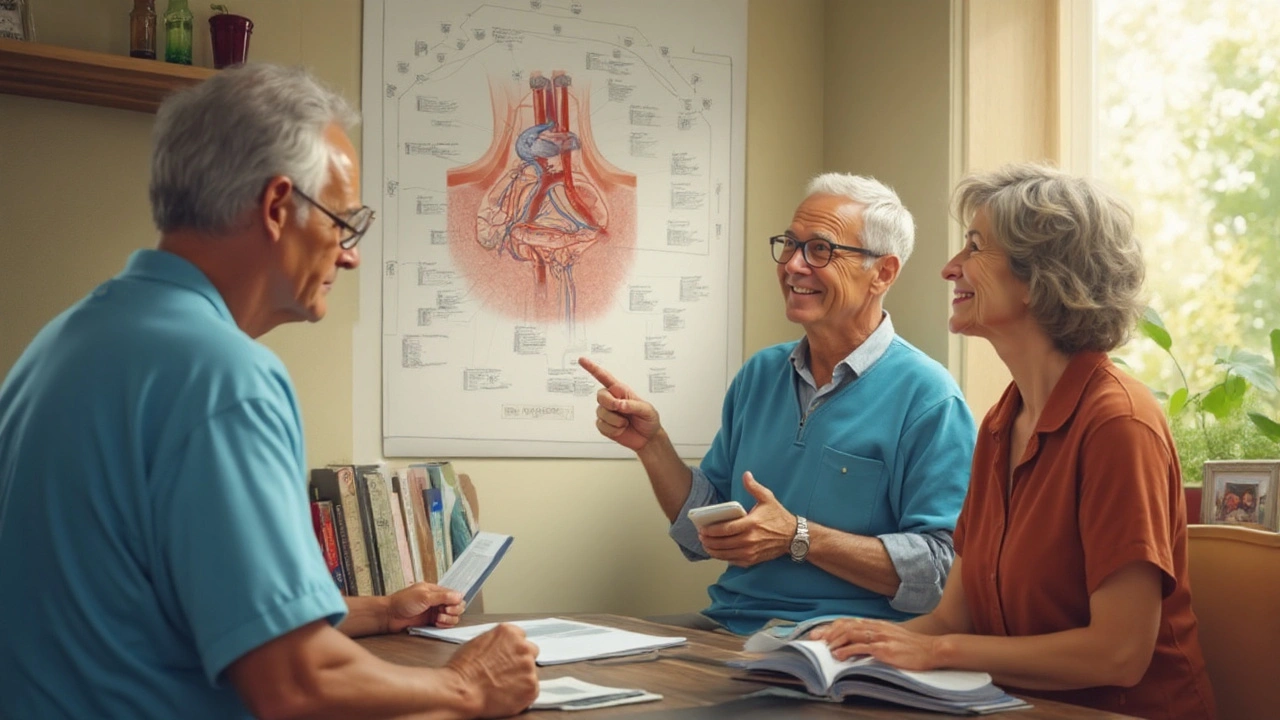The name Cardura makes some people think of superhero comics or heavy metal bands, not a tiny tablet you might swallow every morning. But if you or someone you care about has high blood pressure or certain prostate problems, Cardura (which goes by the less catchy name doxazosin) could end up being a quiet hero. It’s been around since the 1980s, turning up in medicine cabinets worldwide, and yet, unless you’ve needed it, you’ve probably never given it a second thought. Want to know why doctors recommend it, how it stacks up against other meds, and what it really does inside your body? Buckle up, because the reality is way more interesting than the average prescription leaflet lets on.
What Is Cardura and How Does It Work?
Cardura, known generically as doxazosin, is part of a drug family called alpha-1 blockers. These aren’t your everyday painkillers or stomach soothers. Instead, they focus on the smooth muscles lining your blood vessels and, for guys, the prostate and bladder neck. Cardura’s main job is simple in theory—help relax these muscles, so blood flows more freely (which brings down your blood pressure) and, for men, helps urine pass more easily if the prostate is making things difficult.
So, how exactly does Cardura pull this off? Alpha-1 receptors are kind of like bouncers at the door of your blood vessels. Normally, when adrenaline hits these receptors, the blood vessels squeeze tight, and blood pressure climbs. Cardura steps in and blocks those bouncers from doing their thing, letting the blood vessels relax and widen instead. Think of it as letting the crowd into a nightclub in a calm, orderly fashion, instead of having everyone jam the doorway at once. Suddenly, your heart doesn’t have to work as hard to push all that blood through narrow pipes.
Where this gets really handy is with conditions like hypertension (high blood pressure) and benign prostatic hyperplasia, or BPH, a fancy term for an enlarged prostate. In both cases, too much constriction causes problems—either in your arteries, raising blood pressure, or in your bladder, making urination tough. Cardura helps smooth things out and keeps everything moving smoothly.
It’s worth mentioning that Cardura isn’t the first medicine most folks try for high blood pressure or prostate problems. Doctors often start with other options, like thiazide diuretics or ACE inhibitors for blood pressure, or tamsulosin for prostate issues. But Cardura gets picked when you need something different, another option for tricky cases, or when you’re dealing with both problems at the same time. The science backs this up: studies published in journals like the British Journal of Urology International show that Cardura brings notable improvements for men struggling with both high blood pressure and BPH. That’s a small but powerful club.
Who Should Take Cardura—And Who Shouldn’t?
Deciding if Cardura is right for you takes more than googling a few side effects. The clearest fit is for adults with stubborn high blood pressure—even after other drugs, like diuretics or beta-blockers, have had a try. It’s also helpful for men with an enlarged prostate who are fed up with getting up all night just to pee and find other remedies don’t cut it.
But like any medicine, Cardura doesn’t belong in everyone’s medicine cabinet. If you’ve ever fainted from low blood pressure or have a history of a condition called orthostatic hypotension—basically, feeling woozy when you stand up—it may make things worse. The risk is highest when you first start or increase your dose. You might have heard about the “first dose effect,” where the very first tablet can sometimes drop your blood pressure so much you get dizzy or even faint. That’s why doctors often tell people to take Cardura at bedtime, so if you do get dizzy, you’re hopefully safe in bed. And if you already have liver issues, Cardura’s processed there, so you’ll need to talk carefully with your doctor—the risk of side effects can shoot up fast.
Pregnant or breastfeeding? There’s not enough evidence to say Cardura is totally safe for your baby, so the official advice is usually “avoid unless you absolutely have to.” With kids, there’s really no reliable safety info—it’s simply not designed for them.
Definitely tell your doctor about every medicine you take, even over-the-counter stuff and herbal teas. Cardura gets along badly with certain drugs, like phosphodiesterase-5 inhibitors (think Viagra), since both can lower your blood pressure at the same time, doubling up on the dizzy risks. Even things like antifungal medications can mix poorly by interfering with how your liver breaks down doxazosin.
Age matters, too. Older adults tend to be more sensitive to blood pressure drops and side effects like falls. If you’re over 65, you might need a lower start and a slower climb to a full dose. That said, loads of pensioners use Cardura safely with regular checkups. One tip if you’re new to Cardura: get off the sofa slowly, especially in the first few weeks. No one wants a faceplant on the living room rug just because of a strong medicine.

Cardura Dosing, Daily Routine, and What to Expect
Figuring out the right Cardura routine is a bit of an art. Tablets come in several strengths, from 1mg up to 8mg, but most doctors start low—1mg at night. If your blood pressure or prostate symptoms aren’t under control after a week or two, your doctor can nudge the dose up step by step. The reason for this slow approach is mainly safety: your body needs time to adjust, and too much doxazosin at once can leave you flat on your back—or curled up dizzy on the floor. That’s why you’ll often hear it’s safer to take your first dose and every increase at bedtime, just in case you react strongly.
Most people take Cardura once a day. There’s also an extended-release version called Cardura XL, which is designed to keep the medicine steadier in your system all day long. Don’t crush or chew those XL pills—the coating matters. With regular Cardura, you can take it with or without food, but if you get stomach upset, try having it with a snack. And if you forget a dose, just skip it and carry on as usual; don’t double-up the next day.
So, what does “life on Cardura” look like? At first, you might notice your blood pressure drifting lower—sometimes more than you expect. In the Cardura studies from the late 1990s, people lowered their top (systolic) number by an average of 8–10 points. Some report peeing more easily within days, especially if they’re dealing with prostate trouble. For blood pressure, the big changes take a few weeks or even a month.
Watch for early side effects: you could feel lightheaded, especially when you stand up quickly, due to how Cardura relaxes your blood vessels. Some people feel tired or get headaches. Swelling or “puffy” ankles can happen if your body holds onto fluid. Men sometimes complain about an odd side effect—retrograde ejaculation—where semen goes backwards into the bladder instead of forward out the usual way. It’s harmless but weird if you’re not expecting it.
It’s smart to keep track of your blood pressure and, if you’re a guy, how your urination changes in the first few weeks. Apps like Blood Pressure Companion or even scribbled notes work fine. Bring these to doctor visits—it saves everyone time and helps spot problems if they start. Some pharmacies lend home blood pressure monitors if you don’t have one. If you start feeling faint, have chest pain, or notice palpitations that won’t quit, ring your GP right away or get checked out at urgent care.
Side Effects and Safety: What You Really Need to Watch
Every medicine comes with a list of possible side effects that sound a bit like sci-fi horror stories, and Cardura is no different. But most people don’t actually get all—or even most—of them. Lightheadedness, dizziness, and tiredness top the list. These aren’t just listed for legal reasons; they show up in large-scale studies and from regular patients.
Why do they happen? The answer ties back to Cardura’s main job—relaxing blood vessels. Blood moves easier, but your body sometimes can’t keep pressure up when you go from lying down to standing, especially when you’re new to the medicine. That’s why doctors nag you to stand up slowly after taking it.
Swollen feet and ankles (a.k.a. peripheral oedema) aren’t rare. If fluid retention gets bad, let your doctor know—sometimes it means your dose needs tweaked or something else is going on. Some who use Cardura for prostate problems feel their heart race now and then. Palpitations aren’t super common, but they do happen. And there’s that curious effect for some men: trouble with ejaculation or a lower sex drive. It’s annoying, but it usually passes or gets better with a lower dose.
There are a few weird but important risks. Cardura can rarely cause something called “Intraoperative Floppy Iris Syndrome” during cataract surgery. Eye surgeons need to know about your Cardura use before the operation, because your pupils might not dilate as expected. There’s also the rare risk of severe allergic reactions—rashes, swelling, or trouble breathing—these aren’t to be brushed off. If anything like that starts, seek help straight away.
Keep your pharmacist in the loop if you’re starting any new medicine, including herbal “remedies.” Grapefruit juice can change how your liver processes some drugs, but Cardura isn’t usually affected—though check with your doctor if you’re uncertain. If you drink alcohol, be cautious: it can make blood pressure drop even more.
Regular check-ins matter. Doctors usually ask for blood pressure readings, ask about falls, and sometimes run kidney or liver blood tests. Cardura can interact with other medications you might need for unrelated health issues. Missing appointments or skipping doses can throw everything off balance, so try to stick to the plan your healthcare team sets up.

Real-World Tips and Daily Life With Cardura
Living with high blood pressure or prostate troubles can be tough enough—to add more worry about medication side effects or routines is annoying. But a few real-world tips can make things smoother. For most, the first big tip is—don’t freak out if you feel dizzy at first. Lots of people do, and it usually fades after the first week or two. Try standing up slowly (feet first, then sit up, then stand), especially when you wake up or have been sitting a long time.
If you’re taking Cardura for high blood pressure, stick with checking your pressure at least once a week at home. Some patients even keep small notebooks so they have readings ready for appointments. If you’re seeing swelling, make a note—show swelling photos to the doctor if you notice your shoes getting tight or the tops of your socks leaving marks.
If bladder or urination problems brought you here, don’t be surprised if the improvement takes a week or two. Combine Cardura with basics: limit evening fluids, don’t skip the loo breaks during the day, and watch for anything that suddenly changes how you pee. For men, sex life questions are common, but usually not a reason to quit—chat with your GP if you’re worried.
Some people worry that skipping one pill will mess everything up. The truth? Missing one dose is rarely a crisis. Just take your next pill at the usual time—never double up. While junk food and salty takeaways make blood pressure meds like Cardura work harder, you don’t have to live on salads. Instead, cut back on salt, stay active (even basic walks help), and try to keep stress down.
Medication reminders help stop you forgetting your tablets. Some folks set a daily phone alarm. Pill organizers work, too. And if you need to travel—yes, you can take Cardura with you, just keep it in its original box or bottle for airport checks.
One more thing: Some brands of doxazosin look almost identical to other tablets—always double check the box and ask the pharmacist if you’re switching manufacturers. If you’re ever given a pill that doesn’t look familiar, don’t guess—ask before you swallow.
Getting used to any long-term medicine takes a little patience, but for thousands of people around the globe, Cardura is the quiet sidekick that keeps their blood pressure in check and their nights less interrupted by the loo. If your doctor offers it as an option, you can walk into that conversation with your eyes open, knowing not just the textbook facts, but the real-life stuff most leaflets skip over. Remember, Cardura isn’t everyone’s first choice—but it’s a proven one for those who need it.
